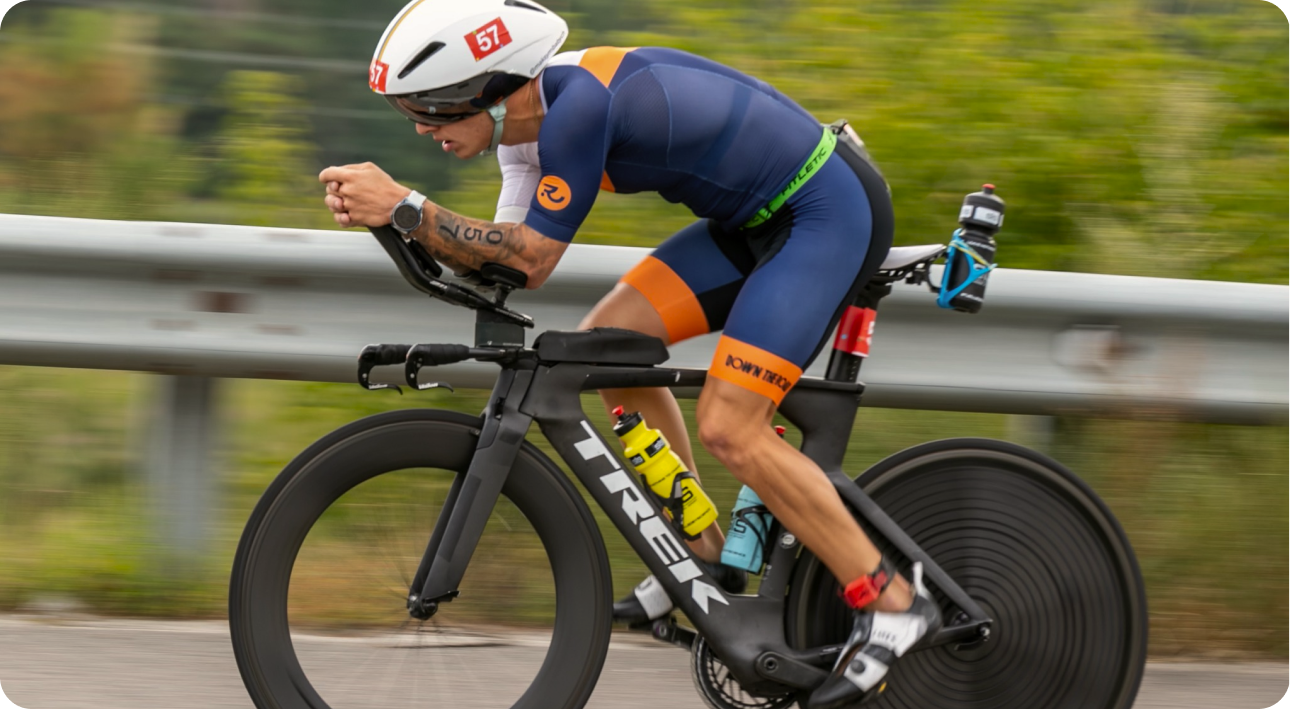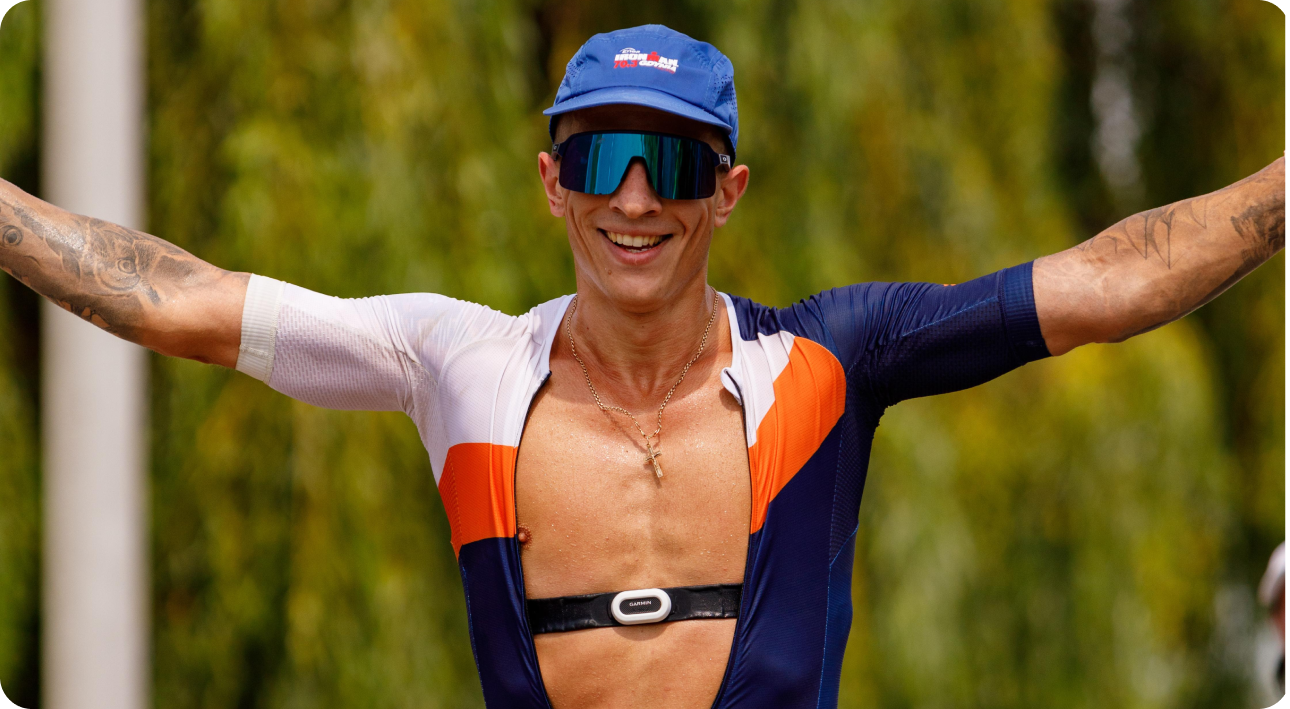Triathlon is the ultimate test of endurance, power, and mental fortitude.
It’s not just about swimming, running, and cycling performance.
It’s about being able to do all three exceptionally well, back-to-back, and that’s where a strong strength and conditioning program comes into play.
In this article, we will discuss the importance of incorporating strength training into your triathlon preparation routine.
We will also share the essential components of an effective strength and conditioning program.
Functional Movements. The Foundation of Strength and Endurance Training
Functional movements are exercises that mimic natural movements and use several muscle groups.
At the same time, they increase overall strength and mobility.
Renowned physical therapist Gray Cook once said, “Functional movement systems lay the foundation for functional training.”
This sums up the essence of why these strength train exercises are crucial for triathletes.
Examples of functional movements include squats, lunges, and deadlifts.
According to the American Council on Exercise, incorporating functional movements into your training can improve overall strength, power, and neuromuscular coordination, all of which are vital for triathlon performance.
Squats, for example, strengthen the entire lower body and abs.
At the same time, they simulate the strength required during the cycling and running stages of a triathlon.
Incorporating the deadlifts into training sessions, on the other hand, is great for developing hip and posterior chain strength.
This is important for efficient running form and powerful cycling.
Powering Up with Compound Exercises
Compound exercises work for multiple muscle groups simultaneously, increasing strength and muscle mass.
Exercises like bench presses, pull-ups, and barbell rows should be an integral part of strength training for triathletes.
In a study published in the Journal of Strength and Conditioning Research, compound exercises were shown to improve power output significantly in cyclists.
This indicates a clear potential advantage for triathletes as well, given the crucial role of cycling in triathlon events.
Core Workouts: Strengthening Your Powerhouse
Regardless of your body composition, your core is your powerhouse.
It helps stabilize your body, maintain balance, and transfer power between the upper and lower body during physical activities.
Renowned strength and conditioning coach Mark Verstegen emphasized this in his book “Core Performance”.
He said: “The benefits of core training include improved balance, greater muscle definition, and improved athletic performance.”
Exercises like planks, bridges, and twists can help level up your core strength.
Stronger core muscles can lead to significant improvements in swimming, cycling, and running mechanics.
This, in turn, can lead to increased performance and reduced risk of injury.
Understanding Periodization: The Key to Balanced Training
Periodization is a systematic approach to endurance training that involves changing training loads over time.
It is necessary to optimize performance and reduce the risk of overtraining.
According to the National Strength and Conditioning Association (NSCA), periodizing your strength training program can increase performance by 20%.
In the context of triathlon training, this can include several variations.
Namely, alternating periods of high-intensity interval training, low-intensity endurance and resistance training, and strength and conditioning exercises.
This approach not only diversifies but also makes the training program interesting.
It also ensures adequate recovery, reducing the risk of overtraining.
Balancing Strength and Conditioning with Discipline-Specific Training
The art of endurance training lies in the balance.
It is about integrating strength and conditioning training into a broader training plan.
It includes discipline-specific training.
Joe Friel, a renowned triathlon coach and author of The Triathlete’s Training Bible, one of the best books about triathlon, shared his quote.
He said: “The key to achieving the best results is training that meets the demands of your race.”
This means that strength training for triathletes should be complementary.
It should not detract from your swimming, cycling, and running training.
For example, if you have a hard bike ride planned, it may be wise to schedule a lighter strength training session to maintain a proper form when cycling.
Then you can focus on recovery or mobility or even rest completely for better performance.
It’s essential to listen to your body and adjust accordingly to avoid overtraining.
Importance of Flexibility and Mobility Work
Triathletes require a good range of motion to perform efficiently in all three disciplines.
Notably, swimming and running performance require a significant amount of muscular endurance, flexibility, and mobility.
Even cycling can benefit from increased hip and hamstring flexibility.
The Journal of Strength and Conditioning conducted a study that was published in Research.
It showed that 8-week static free weights stretching program significantly improved running economy in trained male runners.
Another study published in the International Journal of Sports Medicine also emphasized that shoulder flexibility plays a key role in swimming performance.
This is why it’s important to incorporate flexibility and mobility work into your training regime.
Techniques can include static stretching, dynamic movements, foam rolling, and yoga.
Remember, this isn’t something to rush through after a workout.
It should be considered an integral part of your training.
Taking Your Performance to the Next Level
A complete strength and conditioning program is a key element in triathlon training. It includes functional movements, compound exercises, and core training. The principles of periodization and balanced training should guide your overall plan.
While regular work on flexibility and mobility improves performance and injury resistance.
As sports nutritionist and renowned author Matt Fitzgerald puts it, “Triathlon is more than a race; it’s a way of life.”
So, make this strength and conditioning program part of your triathlon lifestyle. It will help you reach new levels of strength, endurance, and performance.
During your triathlon training, don’t forget to track your progress. Modify your training based on your progress and keep looking for ways to challenge yourself.
After all, every step, every stroke, every pedal, is a move towards becoming a stronger, faster, and more efficient triathlete.
References
1. Cook, G. (2010). Movement: Functional movement systems.
2. Verstegen, M. (2004). Core performance.
3. Friel, J. (2016). The triathlete’s training bible.
4. Fitzgerald, M. (2009). Racing weight: how to get lean for peak performance.
5. Journal of Strength and Conditioning ResearchEffects of strength training on cycling performance, running economy, and muscle power in triathletes.
6. National Strength and Conditioning Association: Periodization training for sports.
7. International Journal of Sports Medicine: Shoulder flexibility and swim performance.
8. American Council on Exercise: Functional Fitness Training.
Developing Your Individual Strength and Conditioning Plan
There is no ‘one-size-fits-all’ training plan. Each triathlete’s needs are unique.
They reflect their strengths and weaknesses, goals, and the special demands of the upcoming competition.
For example, an athlete preparing for a hilly course may combine loads.
In this case, workouts may contain circuit training sessions, leg presses, ankle strength exercises, etc.
Creating your own strength and conditioning plan is like crafting a recipe for success in your fitness journey.
Here’s how you can develop your individual plan:
Assess Your Goals
Start by clarifying what you want to achieve. Whether it’s building muscle, improving endurance and muscle strength, reducing body fat, or enhancing overall fitness, understanding your goals will shape your plan.
For example, if your goal is to improve endurance for a triathlon, your plan might want to include strength training exercises that target cardiovascular fitness and muscular endurance.
Know Your Starting Point
Assess your current fitness level to determine where you are and where you need to go. This includes evaluating strength, flexibility, cardiovascular fitness, and any areas of weakness or imbalance.
You might perform fitness tests like push-ups, squats, and a timed run to gauge your current abilities.
Design Your Program
Based on your goals and starting point, design a program that includes a variety of exercises targeting different muscle groups and fitness components. Include both strength sessions and cardiovascular exercises for balanced development.
Your program might include strength exercises like squats, lunges, leg press, and push-ups, as well as cardiovascular activities like cycling, running, or swimming.
Progression and Variation
Gradually increase the intensity, duration, or difficulty of your workouts over time to continue challenging your body and making progress. Incorporate different exercises and workout formats to keep things interesting and prevent boredom.
Start with lighter weights and fewer repetitions, then gradually increase the weight and reps as you get stronger. You might also try different variations of exercises to target muscles from different angles.
Listen to Your Body
Pay attention to how your body responds to the training program. If you experience pain or discomfort, adjust your workouts accordingly, and don’t push through excessive fatigue or soreness.
If you feel excessively tired or notice persistent pain during or after a workout, it’s a sign that you may need to dial back the intensity or take an extra rest day.
Include Rest and Recovery
Schedule rest days into your plan to allow your body to recover and adapt to the training stimulus. This is crucial for strength gains and preventing overtraining and injury. Aim for at least one or two rest days per week, or incorporate active recovery activities like yoga or walking on rest days.
Track Your Progress
Keep track of your workouts, progress, and any changes you make to your plan. This will help you stay accountable and make adjustments as needed to continue moving toward your goals.
Use a fitness journal, spreadsheet, or fitness app to record your workouts, sets, reps, weights, and how you feel during and after each session.
Remember, developing a strength and conditioning plan is a personalized process that requires experimentation and adaptation based on your individual needs and preferences.
Be patient, stay consistent, and celebrate your progress along the way!
You can also hire a professional coach to create a training program tailored to your needs and goals.

Balancing Strength and Conditioning with Discipline-Specific Training
Balancing maximum strength and conditioning with discipline-specific training is like juggling multiple balls at once — you want to keep them all in the air without dropping any. Here’s how to find that balance:
Understand Your Sport’s Demands
Start by understanding the specific physical requirements of your sport or discipline. Different sports have different movement patterns, placing different demands on the body. So tailor your training to match those demands.
If you’re a swimmer, you’ll need to focus on developing upper body strength and cardiovascular endurance, while a cyclist might prioritize leg strength and power.
Prioritize Discipline-Specific Training
Your primary focus should be on training that directly improves your performance in your sport to generate force. This means dedicating the majority of your training time to sport-specific skills, drills, and workouts.
Incorporate Strength and Conditioning Wisely
Strength and conditioning work should complement your discipline-specific training, not compete with it. Include strength and conditioning sessions that target areas of weakness or enhance performance without detracting from your sport-specific training.
Schedule Smartly
Organize your training schedule to balance discipline-specific training with strength and conditioning work. This might involve alternating days of sport-specific training with days of strength and conditioning or incorporating both types of training within the same workout session.
A triathlete might swim on one day, bike on another, and run on a third while also including strength training sessions on non-swim, bike, or run days.
Listen to Your Body
Pay attention to how your body responds to training and adjust your plan accordingly. If you’re feeling fatigued or overworked, it may be a sign that you need to dial back on one type of training to prevent burnout or injury.
If you’re feeling excessively sore or tired after strength training sessions, you might need to reduce the intensity of those workouts or use low weight to allow for adequate recovery.
Periodize Your Training
Periodization involves dividing your training into distinct phases, each with its own focus and intensity level. Incorporate periods of higher intensity strength and conditioning work during off-season or base training phases, and prioritize sport-specific training as competition season approaches.
By finding the right balance between strength and conditioning work and discipline-specific training, you can maximize your performance potential while minimizing the risk of overtraining or burnout before the race day.
Prioritize quality over quantity, and always listen to your body to ensure you’re training effectively and safely.
Remember the wisdom of Bill Bowerman, legendary running coach and co-founder of Nike: “There is no such thing as bad weather, just soft people.” So, even if conditions are not ideal, keep your focus and balance your workouts for optimal results.

Conclusion
Strength and conditioning are essential parts of a triathlon training program.
They build power, increase endurance, and enhance performance in swimming, cycling, and running.
A well-designed program should involve functional movements, compound exercises, and core workouts.
Keep a balance between strength and conditioning training and discipline-specific training. Do not forget the importance of working on flexibility and mobility.
This will help improve performance and triathlon injury protection. Whether you are a beginner or an advanced triathlete, the right strength and conditioning program can improve your performance.
As six-time Ironman World Champion Mark Allen said, “Triathlon doesn’t build character. It reveals it.”
So, embrace the journey of continuous self-improvement that triathlon training offers. And let your strength and conditioning program reveal the champion within you.








